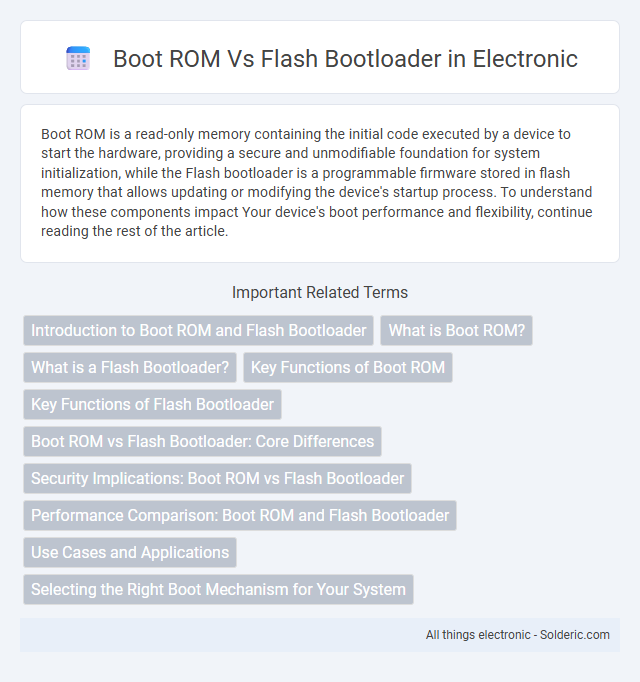Boot ROM is a read-only memory containing the initial code executed by a device to start the hardware, providing a secure and unmodifiable foundation for system initialization, while the Flash bootloader is a programmable firmware stored in flash memory that allows updating or modifying the device's startup process. To understand how these components impact Your device's boot performance and flexibility, continue reading the rest of the article.
Comparison Table
| Feature | Boot ROM | Flash Bootloader |
|---|---|---|
| Location | Embedded in SoC (Read-Only Memory) | Stored in Flash memory (Writable) |
| Mutability | Fixed, cannot be changed or updated | Updatable via firmware update |
| Primary Function | Initial hardware initialization and bootstrapping | Loads the main application firmware after Boot ROM |
| Security | Secure, less vulnerable to tampering | Potentially vulnerable unless protected by security measures |
| Customization | Not customizable | Fully customizable to support various boot modes and protocols |
| Size | Small, minimal size embedded in silicon | Typically larger, defined by Flash sector size |
| Examples | ARM Cortex-M Boot ROM | U-Boot, custom Flash bootloaders |
Introduction to Boot ROM and Flash Bootloader
Boot ROM is a fixed, non-volatile memory embedded in a device's hardware, responsible for initializing system hardware and executing the first-stage boot code upon power-up. Flash bootloader resides in rewritable flash memory, allowing updates and customization to control the subsequent loading of the operating system or application firmware. Understanding the differences between Boot ROM and Flash bootloader helps optimize your device's startup process and firmware management.
What is Boot ROM?
Boot ROM is a non-volatile memory embedded in microcontrollers or processors that contains the initial code executed during device startup, enabling hardware initialization and loading of the primary bootloader. It provides a secure, immutable foundation for the boot process, ensuring that the system can start reliably even if external storage is corrupted or absent. Designed for critical low-level operations, Boot ROM directs the execution flow from power-on or reset to the Flash bootloader or operating system.
What is a Flash Bootloader?
A Flash Bootloader is a specialized program embedded in non-volatile memory that initializes hardware and loads the main operating system or application firmware during device startup. It enables firmware updates, recovery processes, and secure boot sequences by managing the transfer and verification of software stored in flash memory. Unlike the Boot ROM, which is a fixed, hard-coded routine in read-only memory, the Flash Bootloader offers flexibility for modifications and enhancements to support various booting requirements.
Key Functions of Boot ROM
Boot ROM serves as the initial code executed by a processor during startup, providing fundamental hardware initialization and security checks before transferring control to the flash bootloader. It verifies the authenticity and integrity of the bootloader to prevent unauthorized code execution and facilitates the loading of the flash bootloader from non-volatile memory. This ensures a secure, reliable boot process by establishing a trusted execution environment prior to OS or application launch.
Key Functions of Flash Bootloader
Flash bootloaders primarily manage firmware updates by enabling in-field programming of embedded systems, ensuring seamless application code installation without external programmers. They support communication protocols such as UART, SPI, or USB to interface with host devices, facilitating reliable data transfer and verification. Boot ROM, in contrast, provides essential low-level initialization and basic hardware startup routines embedded permanently within the microcontroller.
Boot ROM vs Flash Bootloader: Core Differences
Boot ROM is a read-only memory embedded in the microcontroller that contains the initial code executed during device startup, providing a secure and immutable boot process. Flash bootloader is a programmable firmware stored in non-volatile flash memory, enabling device firmware updates and customizable initialization routines after the Boot ROM phase. The core difference lies in Boot ROM's permanent, hardware-level role, while the Flash bootloader offers flexibility and upgradeability during subsequent boot stages.
Security Implications: Boot ROM vs Flash Bootloader
Boot ROM offers a hardware-embedded security advantage by executing a fixed, immutable code that reduces vulnerability to tampering or malware injection during the boot process. Flash bootloaders, while more flexible and updatable, present potential security risks because their code can be modified or corrupted, increasing exposure to attacks such as unauthorized firmware updates or boot-time compromises. Ensuring your system's security requires balancing the immutable trust of Boot ROM with the adaptability of flash bootloaders, often by integrating cryptographic verification and secure boot mechanisms.
Performance Comparison: Boot ROM and Flash Bootloader
Boot ROM offers faster boot times due to its execution from on-chip memory with lower latency, whereas Flash bootloader depends on reading from external or slower flash storage, impacting overall startup speed. Performance differences become critical in time-sensitive applications where rapid initialization directly affects system responsiveness. Your choice between Boot ROM and Flash bootloader should consider the specific latency and speed requirements of your embedded system.
Use Cases and Applications
Boot ROM is embedded in the microprocessor, providing a secure, immutable startup routine essential for device initialization and system recovery in embedded systems or industrial applications. Flash bootloaders offer flexible firmware updates and customization, commonly used in consumer electronics and IoT devices requiring ongoing maintenance or feature upgrades. Embedded systems prioritize Boot ROM for trusted execution at power-on, while Flash bootloaders enable versatile application deployment and remote system updates.
Selecting the Right Boot Mechanism for Your System
Selecting the right boot mechanism for your system hinges on balancing flexibility and security between Boot ROM and Flash bootloader options. Boot ROM offers a secure, immutable startup code embedded in hardware, ensuring trusted initialization and resistance to tampering, while Flash bootloader provides customizable, updatable firmware enabling feature enhancements and bug fixes post-deployment. Evaluating system requirements, update frequency, and security posture is essential to determine whether the fixed reliability of Boot ROM or the adaptability of Flash bootloader best aligns with your application needs.
Boot ROM vs Flash bootloader Infographic

 solderic.com
solderic.com